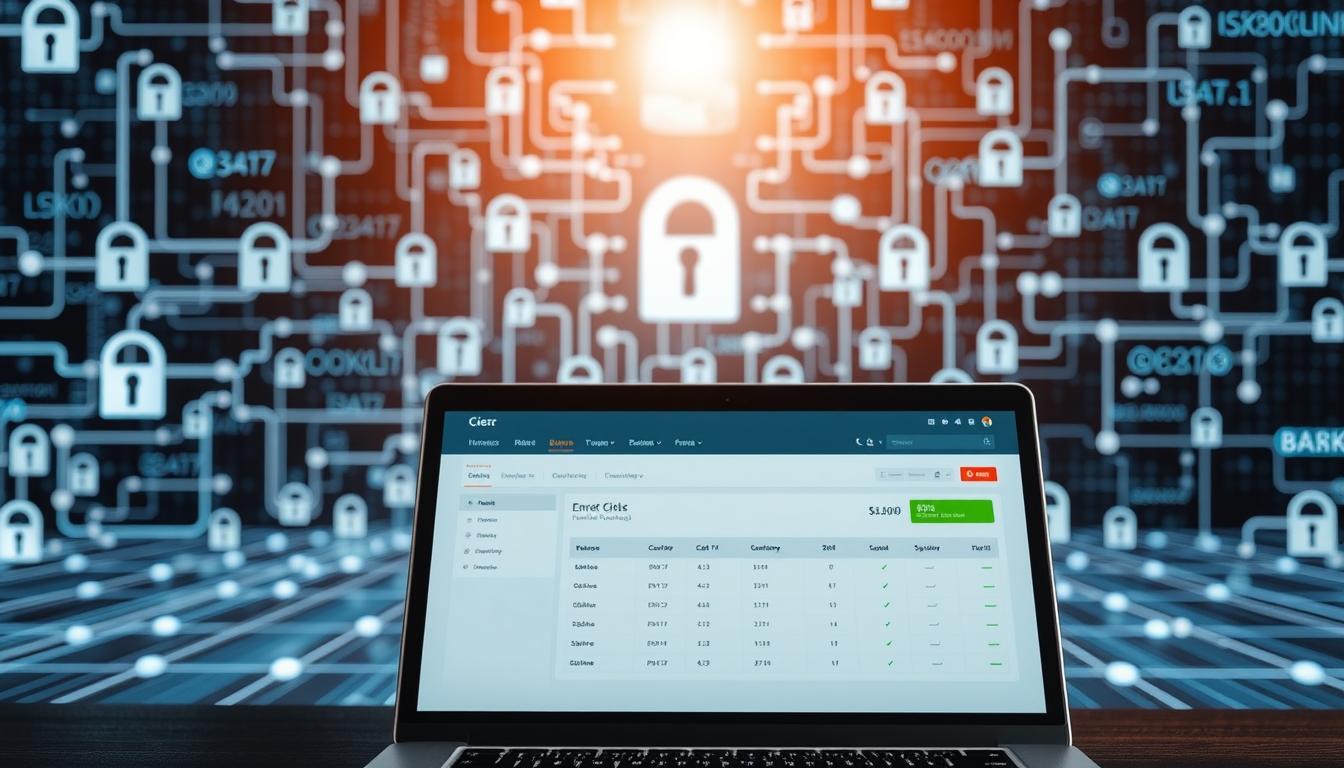How to Avoid Common Online Banking Scams
In today’s digital age, protecting your finances is crucial. Cybersecurity plays a vital role in maintaining your financial security. With the rise of online banking, the risk of falling victim to online banking scams has increased.
To safeguard your financial information, it’s essential to be aware of the common scams that can compromise your security. By understanding the risks and taking proactive measures, you can significantly reduce the likelihood of becoming a victim.
Staying informed about the latest cybersecurity threats and best practices will help you navigate the world of online banking with confidence.
Understanding the Threat Landscape of Online Banking Scams
Understanding the threat landscape is crucial to avoiding online banking scams. The Federal Trade Commission reported over $10 million in fraud losses in 2023, a 14% increase from the previous year. This significant rise underscores the evolving nature of online banking scams.
Cybersecurity threats are becoming more sophisticated, with scammers using various channels such as email, phone calls, and text messages to deceive victims. The threat landscape of online banking scams is complex and multifaceted.
To stay safe, it’s essential to be aware of these threats and understand how they operate. By being informed, individuals can better protect themselves against online banking scams.
Staying vigilant and knowing the common tactics used by scammers can significantly reduce the risk of falling victim to online banking scams.
Recognizing Phishing Attacks in Online Banking
The rise of online banking has been accompanied by a surge in phishing attacks, designed to deceive users into divulging sensitive information. These attacks can lead to significant financial losses and compromise personal data.
Phishing attacks often involve deceptive messages that appear to be from legitimate sources, such as banks or financial institutions. These messages may ask users to click on suspicious links or provide login credentials.
Examples of Deceptive Messages
Deceptive messages can take many forms, including emails, texts, or even phone calls. They often contain vague details or generic greetings, such as “Dear customer,” rather than addressing the user by their name.
Another common trait of phishing attacks is the inclusion of suspicious links or attachments. These links may lead to spoofed websites that mimic legitimate banking sites, aiming to capture login information.

To avoid falling victim to phishing attacks, it’s crucial to be vigilant. Look out for spelling and grammar mistakes in messages, and never click on links from unsolicited emails or texts. Always verify the authenticity of messages by contacting your bank directly.
By being aware of these tactics and taking proactive steps, you can significantly reduce the risk of falling prey to phishing attacks and protect your online banking security.
How to Avoid Common Online Banking Scams Through Secure Practices
Online banking scams can be effectively avoided by implementing robust security measures. One of the critical aspects of secure online banking is understanding the risks associated with using public Wi-Fi networks.
Public Wi-Fi Dangers
Using public Wi-Fi for online banking can expose your data to scammers. Public Wi-Fi networks are often unsecured, making it easy for hackers to intercept your information. It’s advisable to avoid using public Wi-Fi for online banking or use a Virtual Private Network (VPN) to encrypt your data.
Setting Up a Secure Home Network
Setting up a secure home network is essential for safe online banking. This involves changing the default password of your router, enabling WPA2 encryption, and regularly updating your router’s firmware. Additionally, using antivirus software and keeping your operating system up to date can further protect your devices from cyber threats.
By adopting these cybersecurity tips and maintaining a secure online environment, you can significantly reduce the risk of falling victim to online banking scams.
Social Engineering Tactics Used by Banking Scammers
To avoid falling prey to online banking scams, it’s crucial to understand social engineering tactics used by banking scammers. These scammers manipulate individuals into divulging sensitive information by posing as bank representatives or using fake profiles on social media.

One common tactic is pretexting, where scammers create a fictional scenario to gain the victim’s trust. They might claim to be from a bank’s fraud department, asking for personal details to “verify” an account. Another tactic is baiting, where victims are promised something in return for their information.
To protect yourself, be cautious when sharing personal information online or over the phone. Verify the authenticity of requests by directly contacting your bank using a known phone number. Being aware of these cybersecurity threats is key to avoiding common online banking scams.
Mobile Banking Security: Protecting Your Smartphone
With the rise of mobile banking, securing your smartphone is more important than ever. Cyber threats are becoming increasingly sophisticated, making it crucial to take proactive measures to protect your device.
Keeping Your Device Updated
Keeping your smartphone updated with the latest software is crucial for security. Outdated software can leave your device vulnerable to malware and other cyber threats. Regular updates often include patches for security vulnerabilities that have been discovered since the last update.
To ensure your smartphone is secure, enable automatic updates for your operating system and banking apps. This way, you’ll always have the latest security features and fixes. Additionally, be cautious when downloading apps, and only use reputable sources like the Apple App Store or Google Play Store.
By staying vigilant and keeping your smartphone updated, you can significantly reduce the risk of falling victim to cyber threats and enjoy a safer mobile banking experience.
Monitoring Your Accounts for Unauthorized Activity
One of the most effective ways to avoid common online banking scams is by regularly checking your accounts. Account monitoring is crucial for detecting unauthorized activity. By keeping a close eye on your transactions, you can quickly identify any suspicious behavior.

To enhance your account security, it’s essential to understand the various transaction verification methods available. These methods can add an extra layer of protection to your online banking.
Transaction Verification Methods
Several transaction verification methods can help secure your online banking. These include:
Using two-factor authentication (2FA) adds a layer of security by requiring a second form of verification, such as a code sent to your phone, in addition to your password.
Regularly reviewing your account statements and transaction history can help you spot any unauthorized transactions.
Setting up account alerts can notify you of any suspicious activity, allowing you to take prompt action.
By implementing these cybersecurity measures and staying vigilant, you can significantly reduce the risk of falling victim to online banking scams. Remember, being proactive is key to How to Avoid Common Online Banking Scams.
Emerging Online Banking Threats to Watch For
As online banking continues to evolve, new threats are emerging that can compromise your financial security. One of the most significant emerging threats is the use of Artificial Intelligence (AI) by scammers to impersonate loved ones or bank representatives.
Staying informed is key to protecting yourself from these evolving scams. It’s essential to be aware of the latest tactics used by cybercriminals, including phishing attacks, social engineering, and malware.
The use of AI-powered chatbots to deceive users is becoming more common. These chatbots can mimic human-like conversations, making it difficult to distinguish between legitimate and malicious interactions.
To stay ahead of these threats, it’s crucial to monitor your accounts regularly and report any suspicious activity to your bank. Additionally, keeping your software and security systems up to date can help protect against malware and other cybersecurity threats.
By staying vigilant and informed, you can reduce the risk of falling victim to emerging online banking threats. Regularly reviewing your bank statements and being cautious with links and attachments from unknown sources can also help safeguard your financial information.
Conclusion: Staying Vigilant in the Digital Banking Era
As we’ve explored throughout this article, staying vigilant is crucial in the digital banking era. By understanding the threat landscape of online banking scams, recognizing phishing attacks, and adopting secure practices, you can significantly reduce the risk of falling victim to cybercrime.
Cybersecurity is a collective responsibility, and staying informed is key to protecting yourself and your finances. By monitoring your accounts regularly and being aware of emerging online banking threats, you can ensure a safe and secure banking experience.
To avoid common online banking scams, it’s essential to remain cautious and informed. By following the tips and best practices outlined in this article, you can enjoy the convenience of digital banking while safeguarding your financial information.







